Difference between revisions of "Luziola bahiensis"
FNA>Volume Importer |
FNA>Volume Importer |
Revision as of 19:16, 24 September 2019
Plants stoloniferous, emergent or immersed. Culms 10-50 cm, suberect to erect. Leaves mostly basal or scattered along the culms, not conspicuously floating or streaming in the current; sheaths glabrous or ciliate; ligules to about 6 mm, lanceolate, acuminate; pseudopetioles sometimes present; blades 3-30(39) cm long, 1-6 mm wide, glabrous or puberulent. Inflorescences panicles; pedicels capillary. Staminate panicles 4-6 cm, terminal, with 9-17 spikelets; staminate florets 4-8 mm; lemmas lanceolate, faintly 5-9-veined; paleas similar, 3-veined; anthers 6, 2-4 mm, linear. Pistillate panicles to about 12 cm, arising from the lower nodes of the culms, all or mostly exserted, with 9-17 spikelets; branches slender, divergent to reflexed; pistillate florets 3-5 mm, caducous; lemmas 8-13-veined, acuminate or caudate; paleas similar, 6-8-veined; stigmas 2-4 mm. Achenes 1.5-2.2 mm, ovoid or broadly ellipsoid, lightly to moderately striate, somewhat lustrous. 2n = 24.
Distribution
Fla., Ala., Miss.
Discussion
Luziola bahiensis is native from the Caribbean south to Argentina. It has been found at scattered locations in southern Louisiana, Mississippi, Alabama, and north-western Florida. It grows in wet places or shallow water along streams and lakes.
Selected References
None.
